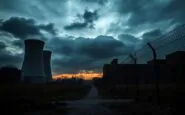Topics Covered
The situation in Ukraine continues to deteriorate, with the conflict now marking day 1.317. Recently, the notorious Chernobyl nuclear site suffered a blackout lasting more than three hours, caused by a Russian attack on a power substation in Slavutych, a town in the Kiev region. This news was confirmed by the Ukrainian president, Volodymyr Zelensky, who expressed concern about the safety of the plant.
In a context of growing uncertainty, the Danish Prime Minister, Puts Frederiksen, stressed the importance of addressing hybrid warfare as a European issue during the European Union summit in Copenhagen. His statement highlights the need for a unified and coordinated response from member states, rather than isolated actions.
International reactions and measures
In response to Russian aggression, the G7 finance ministers They met virtually to discuss joint economic measures. They agreed to intensify pressure on Moscow, particularly targeting those who continue to rely on Russian oil and those who facilitate sanctions evasion. This approach aims to limit the revenue Russia could earn from its energy exports.
Embargo and sanctions strategies
During the meeting, representatives also discussed potential duties and import and export bans, with the aim of further reducing the flow of money into Russian coffers. The trade policies to be implemented will be crucial to supporting Ukraine and sending a clear signal of condemnation of Russian aggression.
Military support and intelligence information
According to what reported by Wall Street Journal, the United States would be ready to provide information intelligence to Ukraine. This information could allow Kiev to carry out long-range missile strikes against Russian energy infrastructure. Anonymous officials revealed that the president Donald Trump would have given the green light to intelligence agencies and the Pentagon to support Ukraine in this operation.
Possible supplies of armaments
Sources also suggested that Washington is considering sending missiles Tomahawk and other long-range weapons to Kiev. However, a final decision on this point has not yet been made. The possibility of increased military assistance from NATO has been raised, signaling growing cooperation between the allies.
In another development, French military have taken control of a so-called oil tanker ghost fleet Russian, flying the Benin flag. The vessel was stopped off the coast of Saint-Nazaire, France, and is suspected of being involved in aerial surveillance, particularly in the drone incident that occurred in Denmark last week. The men in camouflage arrested the captain and his deputy for their involvement.
Returning to the Chernobyl site, the Director General of the International Atomic Energy Agency (IAEA), Rafael Grossi, recently reported that, after the power loss, the plant was quickly reactivated on alternative power lines. However, the New Safe Confinement (NSC), built to protect the old sarcophagus after the 1986 disaster, remains powered by emergency diesel generators. This episode highlights the vulnerabilities of critical infrastructure in a conflict context.
The situation in Ukraine and its global implications continue to evolve, requiring constant vigilance from the international community. The economic and military measures adopted by various G7 countries and NATO could represent a significant shift in the course of the conflict.

